Convection Parametrization and Multi-Nesting Dependence of a Heavy Rainfall Event over Namibia with Weather Research and Forecasting (WRF) Model
Abstract
:1. Introduction
2. Model, Data and Simulations
3. Event Description
4. Results
4.1. Observations Comparison
4.2. Effect of Multi-Nesting
4.3. Effect of the Convection Scheme
5. Summary and Conclusions
Author Contributions
Funding
Acknowledgments
Conflicts of Interest
References
- Reid, H.; Sahlén, L.; Stage, J.; Macgregor, J. Climate change impacts on Namibia’s natural resources and economy. Clim. Policy 2008, 8, 452–466. [Google Scholar] [CrossRef]
- Mulwa, C.; Visser, M. Farm diversification as an adaptation strategy to climatic shocks and implications for food security in northern Namibia. World Dev. 2020, 129, 104906. [Google Scholar] [CrossRef]
- Teweldemedhin, M.; Durand, W.; Crespo, O.; Beletse, Y.; Nhemachena, C. Economic impact of climate change and benefit of adaptations for maize production: Case from Namibia, Zambezi region. J. Dev. Agric. Econ. 2015, 7, 61–71. [Google Scholar] [CrossRef] [Green Version]
- Newsham, A.; Thomas, D. Knowing, farming and climate change adaptation in North-Central Namibia. Glob. Environ. Chang. 2011, 21, 761–770. [Google Scholar] [CrossRef] [Green Version]
- Tyson, P. Climatic Change and Variability in Southern Africa; Oxford University Press: Oxford, UK, 1986; p. 220. [Google Scholar]
- Mason, S.; Jury, M. Climatic variability and change over southern Africa: A reflection on underlying processes. Prog. Phys. Geog. 1997, 21, 23–50. [Google Scholar] [CrossRef]
- Howard, E.; Washington, R. Characterizing the synoptic expression of the angola low. J. Clim. 2018, 31, 7147–7165. [Google Scholar] [CrossRef]
- Vigaud, N.; Pohl, B.; Crétat, J. Tropical-temperate interactions over Southern Africa simulated by a regional climate model. Clim. Dyn. 2012, 39, 2895–2916. [Google Scholar] [CrossRef]
- Walker, N. Links Between South African Summer Rainfall and Temperature Variability of the Agulhas and Benguela Current Systems. J. Geophys. Res. 1990, 95, 3297–3319. [Google Scholar] [CrossRef]
- Harrison, M. A generalised classification of South African Summer rain bearing synoptic systems. J. Climatol. 1984, 4, 547–560. [Google Scholar] [CrossRef]
- Todd, M.; Washington, R. Circulation anomalies with tropical-temperate troughs in Southern Africa and the South West Indian Ocean. Clim. Dyn. 1999, 15, 937–951. [Google Scholar] [CrossRef]
- Tyson, P.; Preston-Whyte, R.A. The Weather and Climate of Southern Africa; Oxford University Press: Oxford, UK, 2000; p. 396. [Google Scholar]
- Engelbrecht, F.A.; Adegoke, A.; Bopape, M.; Naidoo, M.; Garland, R.; Thatcher, M.; Katzfey, J.; Werner, M. Projections of rapidly rising surface temperatures over Africa under low mitigation. Environ. Res. Lett. 2015, 10, 085004. [Google Scholar] [CrossRef]
- IPCC. Technical Summary: Global Warming of 1.5 °C. An IPCC Special Report on the Impacts of Global Warming of 1.5 C above Pre-Industrial Levels and Related Global Greenhouse Gas Emission Pathways, in the Context of Strengthening the Global Response to the Threat of Climate Change, Sustainable Development, and Efforts to Eradicate Poverty; IPCC: Paris, France, 2018. [Google Scholar]
- Dirkx, E.; Hager, C.; Tadross, M.; Bethune, S.; Curtis, B. Climate Change Vulnerability & Adaptation Assessment Namibia; Desert Research Foundation Namibia & Climate Systems Analysis Group, UCT: Cape Town, South Africa, 2008. [Google Scholar]
- Ellis, H.; Matjila, J. After Devastating Floods, Namibians Fight Cholera and Wait for a Return to Normalcy. UNICEF info by Country; UNICEF: Geneva, Switzerland, 2008. [Google Scholar]
- Government of the Republic of Namibia. Post Disaster Needs Assessment (PDNA); Government of the Republic of Namibia: Windhoek, Namibia, 2009.
- Bauer, P.; Thorpe, A.; Brunet, G. The quiet revolution of numerical weather prediction. Nature 2015, 525, 47–55. [Google Scholar] [CrossRef] [PubMed]
- Holton, J.R.; Hakim, G. An Introduction to Dynamic Meteorology; Academic Press: Cambridge, MA, USA, 2014; p. 552. [Google Scholar]
- Stensrud, D. Parametrization schemes. Keys to understanding numerical weather prediction models. Reprint of the 2007 hardback ed.; In Parameterization Schemes: Keys to Understanding Numerical Weather Prediction Models; Elsevier: Amsterdam, The Netherlands, 2007; p. 480. [Google Scholar] [CrossRef]
- Steeneveld, G.J.; Peerlings, E. Mesoscale Model Simulation of a Severe Summer Thunderstorm in The Netherlands: Performance and Uncertainty Assessment for Parameterised and Resolved Convection. Atmosphere 2020, 11, 811. [Google Scholar] [CrossRef]
- Staniforth, A. Regional modeling: A theoretical discussion. Meteorol. Atmos. Phys. 1997, 63, 15–29. [Google Scholar] [CrossRef]
- Champion, A.; Hodges, K. Importance of resolution and model configuration when downscaling extreme precipitation. Tellus A 2014, 66. [Google Scholar] [CrossRef] [Green Version]
- Wang, Y.; Leung, L.; McGregor, J.; Lee, D.K.; Wang, W.C.; Ding, Y.; Kimura, F. Regional Climate Modeling: Progress, Challenges, and Prospects. J. Meteorol. Soc. Jpn. 2004, 82, 1599–1628. [Google Scholar] [CrossRef] [Green Version]
- Bopape, M.M.; Sithole, H.; Motshegwa, T.; Rakate, E.; Engelbrecht, F.; Morgan, A.; Ndimeni, L.; Botai, O.J. A Regional Project in Support of the SADC Cyber-Infrastructure Framework Implementation: Weather and Climate. Data Sci. J. 2019, 18, 34. [Google Scholar] [CrossRef] [Green Version]
- Motshegwa, T.; Wright, C.; Sithole, H.; Ngolwe, C.; Morgan, A. Developing a Cyber-infrastructure for Enhancing Regional Collaboration on Education, Research, Science, Technology and Innovation. In Proceedings of the 2018 IST-Africa Week Conference (IST-Africa), Gaborone, Botswana, 9–11 May 2018; pp. 1–9. [Google Scholar]
- Wu, X.; Li, X. A review of cloud-resolving model studies of convective processes. Adv. Atmos. Sci. 2008, 25, 202–212. [Google Scholar] [CrossRef]
- Clark, P.; Roberts, N.; Lean, H.; Ballard, S.; Charlton-Perez, C. Convection-permitting models: A step-change in rainfall forecasting. Meteorol. Appl. 2016, 23. [Google Scholar] [CrossRef] [Green Version]
- Woodhams, B.; Birch, C.; Marsham, J.; Bain, C.; Roberts, N.; Boyd, D. What is the added-value of a convection-permitting model for forecasting extreme rainfall over tropical East Africa? Mon. Weather Rev. 2018, 146. [Google Scholar] [CrossRef]
- Xu, K.M.; Cederwall, R.; Donner, L.; Grabowski, W.W.; Guichard, F.; Johnson, D.; Khairoutdinov, M.; Krueger, S.; Petch, J.; Randall, D.; et al. An Intercomparison of Cloud-Resolving Models with the ARM Summer 1997 IOP Data. Q. J. R. Meteorol. Soc. 2001, 128, 593–624. [Google Scholar] [CrossRef] [Green Version]
- Skamarock, W.C.; Klemp, J.B.; Dudhia, J.; Gill, D.O.; Liu, Z.; Berner, J.; Huang, X.Y. A Description of the Advanced Research WRF Model Version 4 (No. NCAR/TN-556+STR); National Center for Atmospheric Research: Boulder, CO, USA, 2019. [Google Scholar]
- Wang, W. WRF: More Runtime Options; WRF Tutorial; UNSW: Sydney, Australia, 2017; p. 46. [Google Scholar]
- Iacono, M.; Delamere, J.; Mlawer, E.; Shepard, M.; Clough, S.; Collins, W. Radiative Forcing by Long-Lived Greenhouse Gases: Calculations with the AER Radiative Transfer Models. J. Geophys. Res. 2008, 113. [Google Scholar] [CrossRef]
- Hong, S.Y.; Noh, Y.; Dudhia, J. A New Vertical Diffusion Package with an Explicit Treatment of Entrainment Processes. Mon. Weather Rev. 2006, 134, 2318–2341. [Google Scholar] [CrossRef] [Green Version]
- Tiedtke, M. A Comprehensive Mass Flux Scheme For Cumulus Parameterization In Large-Scale Models. Mon. Weather Rev. 1989, 117. [Google Scholar] [CrossRef] [Green Version]
- Zhang, C.; Wang, Y.; Hamilton, K. Improved Representation of Boundary Layer Clouds over the Southeast Pacific in ARW-WRF Using a Modified Tiedtke Cumulus Parameterization Scheme*. Mon. Weather Rev. 2011, 139, 3489–3513. [Google Scholar] [CrossRef] [Green Version]
- Zhang, C.; Wang, Y. Projected Future Changes of Tropical Cyclone Activity over the Western North and South Pacific in a 20-km-Mesh Regional Climate Model. J. Clim. 2017, 30, 5923–5941. [Google Scholar] [CrossRef]
- Hong, S.Y.; Kim, J.H.; Lim, J.O.; Dudhia, J. The WRF single moment microphysics scheme (WSM). J. Korean Meteorol. Soc. 2006, 42, 129–151. [Google Scholar]
- Ratna, S.; Ratnam, J.V.; Behera, S.; Rautenbach, C.; Ndarana, T.; Takahashi, K.; Yamagata, T. Performance assessment of three convective parameterization schemes in WRF for downscaling summer rainfall over South Africa. Clim. Dyn. 2013, 42, 358. [Google Scholar] [CrossRef] [Green Version]
- Crétat, J.; Pohl, B.; Richard, Y.; Drobinski, P. Uncertainties in simulating regional climate of Southern Africa: Sensitivity to physical parameterizations using WRF. Clim. Dyn. 2011, 38, 613–634. [Google Scholar] [CrossRef]
- Sun, B.Y.; Bi, X. Validation for a tropical belt version of WRF: Sensitivity tests on radiation and cumulus convection parameterizations. Atmos. Ocean. Sci. Lett. 2019, 1–9. [Google Scholar] [CrossRef] [Green Version]
- Gbode, I.; Dudhia, J.; Vincent, A. Sensitivity of different physics schemes in the WRF model during a West African monsoon regime. Theor. Appl. Climatol. 2018, 1–19. [Google Scholar] [CrossRef] [Green Version]
- Sela, J. Implementation of the sigma pressure hybrid coordinate into GFS. Ncep Off. Note 2009, 461, 1–25. [Google Scholar]
- Maidment, R.; Grimes, D.; Black, E.; Tarnavsky, E.; Young, M.; Greatrex, H.; Allan, R.; Stein, T.; Nkonde, E.; Senkunda, S.; et al. A new, long-term daily satellite-based rainfall dataset for operational monitoring in Africa. Sci. Data 2017, 4. [Google Scholar] [CrossRef]
- Tarnavsky, E.; Grimes, D.; Maidment, R.; Black, E.; Allan, R.; Stringer, M.; Chadwick, R.; Kayitakire, F. Extension of the TAMSAT Satellite-Based Rainfall Monitoring over Africa and from 1983 to Present. J. Appl. Meteorol. Clim. 2014, 53, 2805–2822. [Google Scholar] [CrossRef] [Green Version]
- Huffman, G.; Bolvin, D.; Braithwaite, D.; Hsu, K.; Joyce, R.; Xie, P. Integrated Multi-SatellitE Retrievals for GPM (IMERG), Version 4.4.; NASA’s Precipitation Processing Center, NASA: Greenbelt, MD, USA, 2014.
- Hersbach, H.; Dee, D. ERA5 Reanalysis is in Production; ECMWF: Reading, UK, 2016. [Google Scholar]
- Chawane, G. Watch: Magnificent Namibia river flood after years of drought. The Citizen, 24 October 2018. [Google Scholar]
- Singleton, A.; Reason, C. Variability in the characteristics of cut-off low pressure systems over subtropical southern Africa. Int. J. Climatol. 2007, 27, 295–310. [Google Scholar] [CrossRef]
- Ndarana, T.; Rammopo, T.S.; Chikoore, H.; Barnes, M.A.; Bopape, M.J. A quasi-geostrophic diagnosis of the zonal flow associated with cut-off lows over South Africa and surrounding oceans. Clim. Dyn. 2020, 55, 2631–2644. [Google Scholar] [CrossRef]
- Ndarana, T.; Mpati, S.; Bopape, M.J.; Engelbrecht, F.; Chikoore, H. The flow and moisture fluxes associated with ridging South Atlantic Ocean anticyclones during the subtropical southern African summer. Int. J. Climatol. 2020. [Google Scholar] [CrossRef]
- Beck, H.; Pan, M.; Roy, T.; Weedon, G.; Pappenberger, F.; van Dijk, A.; Huffman, G.; Adler, R.; Wood, E. Daily evaluation of 26 precipitation datasets using Stage-IV gauge-radar data for the CONUS. Hydrol. Earth Syst. Sci. 2019, 23, 207–224. [Google Scholar] [CrossRef] [Green Version]
- Laprise, R.; RaviVarma, M.; Denis, B.; Caya, D.; Zawadzki, I. Predictability of a Nested Limited-Area Model. Mon. Weather Rev. 2000, 128, 4149–4154. [Google Scholar] [CrossRef]
- Warner, T.T.; Peterson, R.A.; Treadon, R.E. A Tutorial on Lateral Boundary Conditions as a Basic and Potentially Serious Limitation to Regional Numerical Weather Prediction. Bull. Am. Meteorol. Soc. 1997, 78, 2599–2618. [Google Scholar] [CrossRef] [Green Version]
- Davies, H.; Turner, R. Sensitivity Updating prediction models by dynamical relaxation: An examination of the technique. Q. J. R. Meteorol. Soc. 1977, 103, 225–245. [Google Scholar] [CrossRef]
- Davies, T. Lateral boundary conditions for limited area models. Q. J. R. Meteorol. Soc. 2014, 140. [Google Scholar] [CrossRef]
- Khairoutdinov, M.F.; Randall, D.A. A cloud resolving model as a cloud parameterization in the NCAR Community Climate System Model: Preliminary results. Geophys. Res. Lett. 2001, 28, 3617–3620. [Google Scholar] [CrossRef]
- Weisman, M.; Skamarock, W.; Klemp, J. The Resolution Dependence of Explicitly Modeled Convective Systems. Mon. Weather Rev. 1997, 125. [Google Scholar] [CrossRef]
- Roberts, N. Assessing the spatial and temporal variation in the skill of precipitation forecasts from an NWP model. Meteorol. Appl. 2008, 15, 163–169. [Google Scholar] [CrossRef] [Green Version]
- Bryan, G.; Wyngaard, J.; Fritsch, J. Resolution Requirements for the Simulation of Deep Moist Convection. Mon. Weather Rev. 2003, 131. [Google Scholar] [CrossRef]
- Keat, W.; Stein, T.; Phaduli, E.; Landman, S.; Becker, E.; Bopape, M.J.; Hanley, K.; Lean, H.; Webster, S. Convective initiation and storm life-cycles in convection-permitting simulations of the Met Office Unified Model over South Africa. Q. J. Roy. Meteor. Soc. 2019. [Google Scholar] [CrossRef] [Green Version]
- Roberts, N. Modelling Extreme Rainfall Events; Technical Report; Department for Environment and Rural Affairs: London, UK, 2008.
- Bopape, M.J.; Engelbrecht, F.; Randall, D.; Landman, W. Simulations of an isolated two-dimensional thunderstorm: Sensitivity to cloud droplet size and the presence of graupel. Asia-Pac. J. Atmos. Sci. 2014, 50. [Google Scholar] [CrossRef] [Green Version]
- Molongwane, C.; Bopape, M.J.; Fridlind, A.; Motshegwa, T.; Matsui, T.; Phaduli, E.; Sehurutshi, B.; Maisha, R. Sensitivity of Botswana Ex-Tropical Cyclone Dineo rainfall simulations to cloud microphysics scheme. AAS Open Res. 2020, 3, 30. [Google Scholar] [CrossRef]
- Matsui, T.; Santanello, J.; Shi, J.; Tao, W.; Wu, D.; Peters-Lidard, C.; Kemp, E.; Chin, M.; Starr, D.; Sekiguchi, M.; et al. Introducing Multi-Sensor Satellite Radiance-based Evaluation for Regional Earth System Modeling. J. Geophys. Res. Atmos. 2014, 119. [Google Scholar] [CrossRef]
- Zhang, S.; Matsui, T.; Cheung, S.; Zupanski, M.; Peters-Lidard, C. Impact of Assimilated Precipitation-Sensitive Radiances on the NU-WRF Simulation of the West African Monsoon. Mon. Weather Rev. 2017, 145. [Google Scholar] [CrossRef]
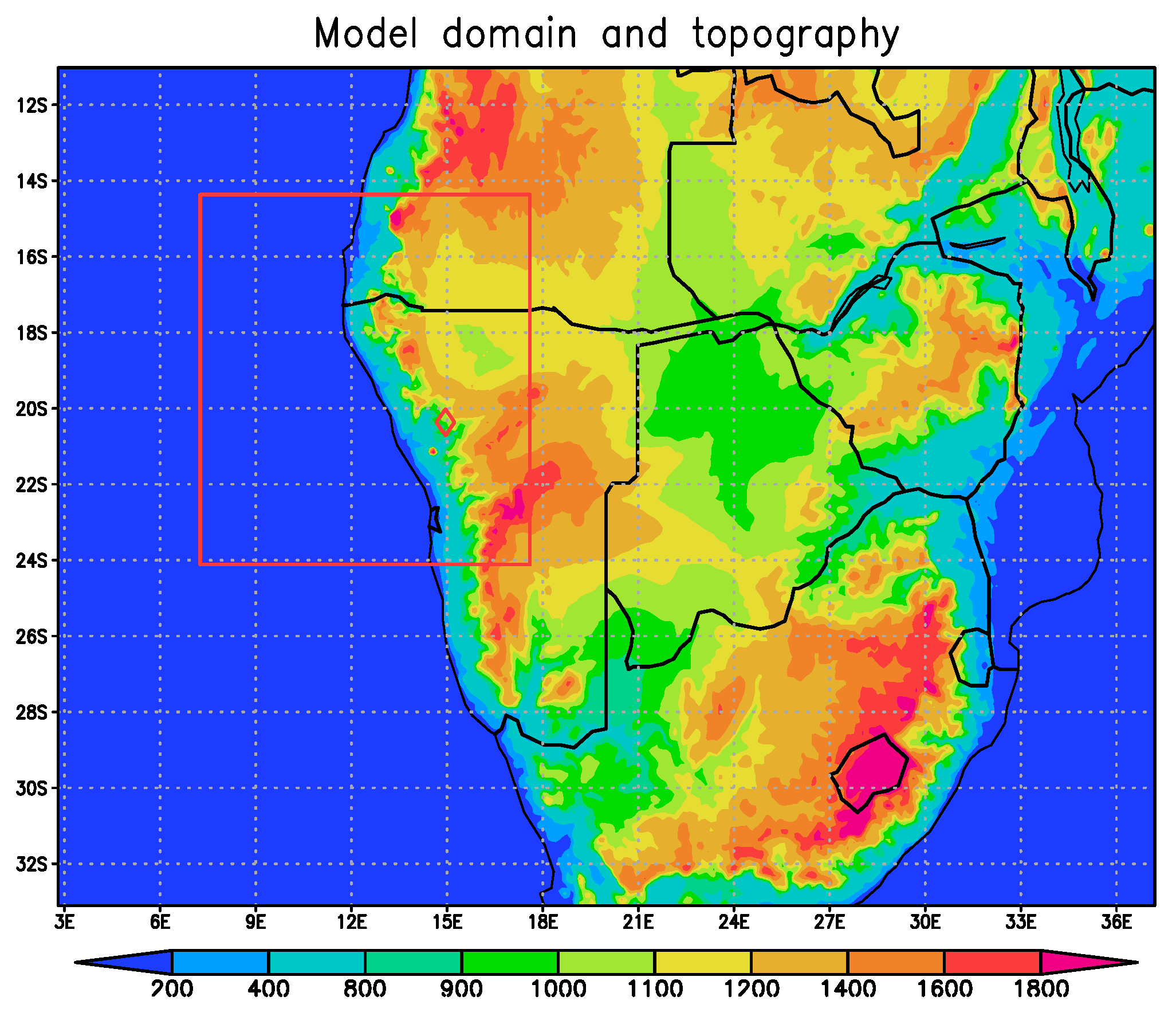
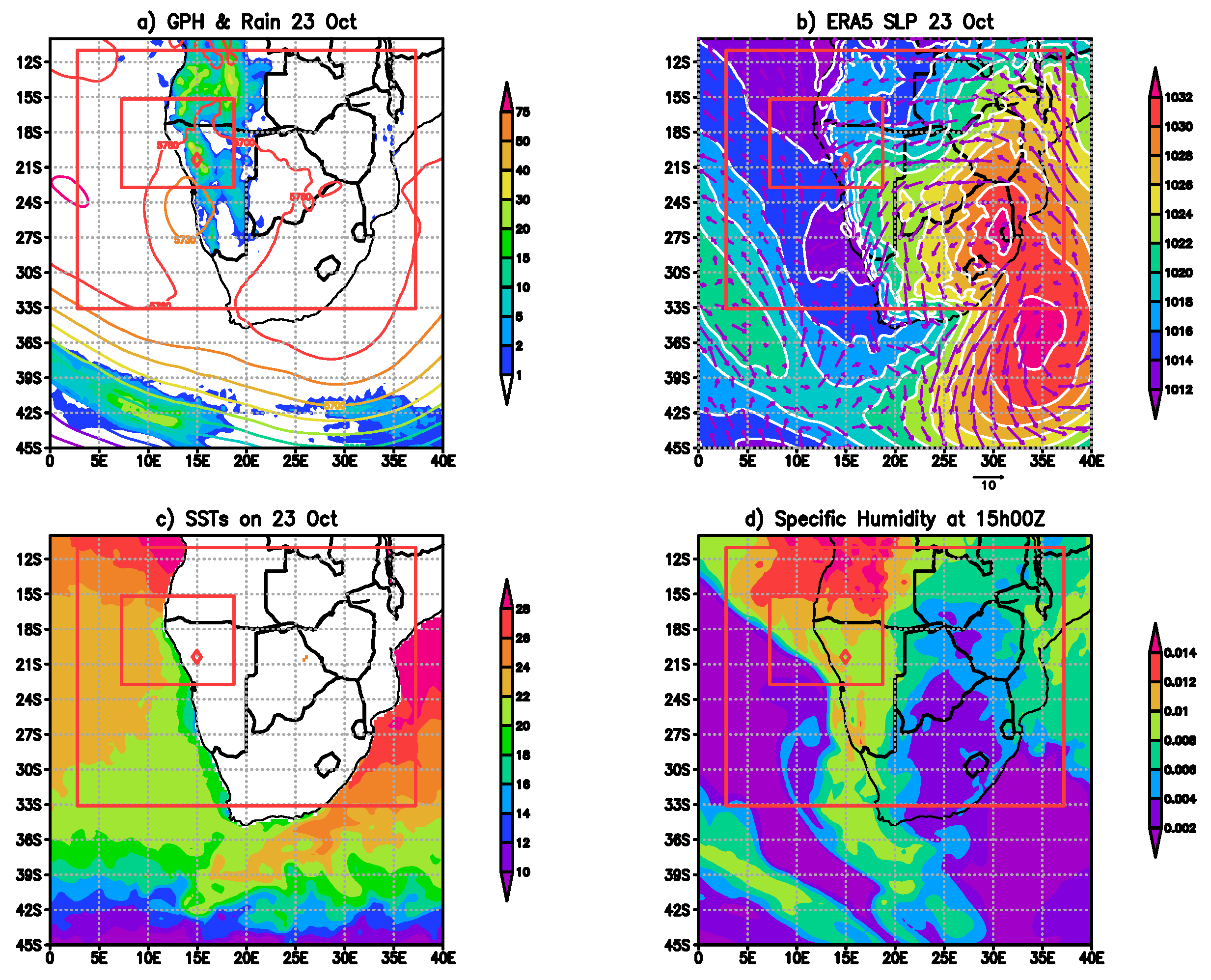

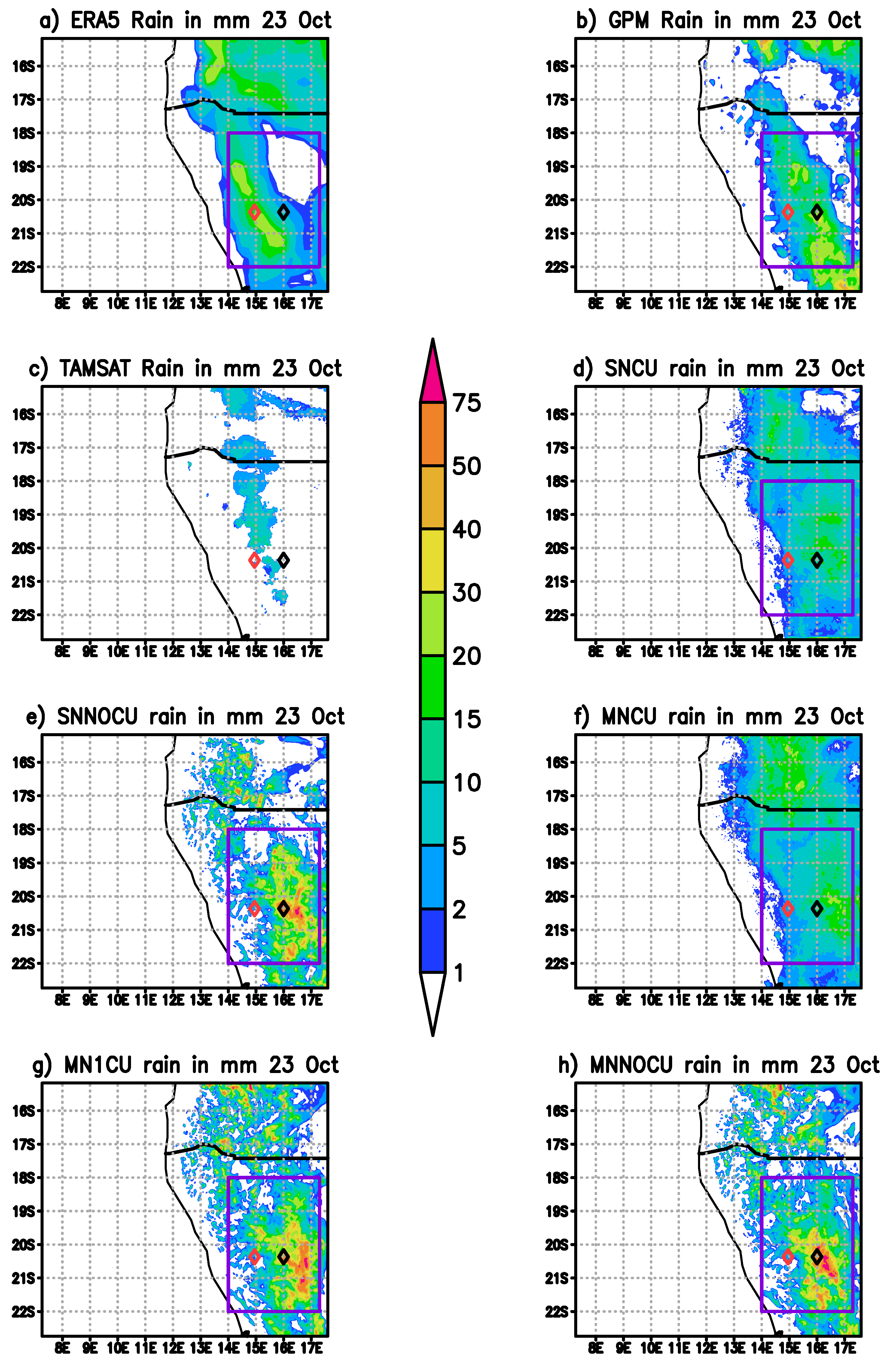
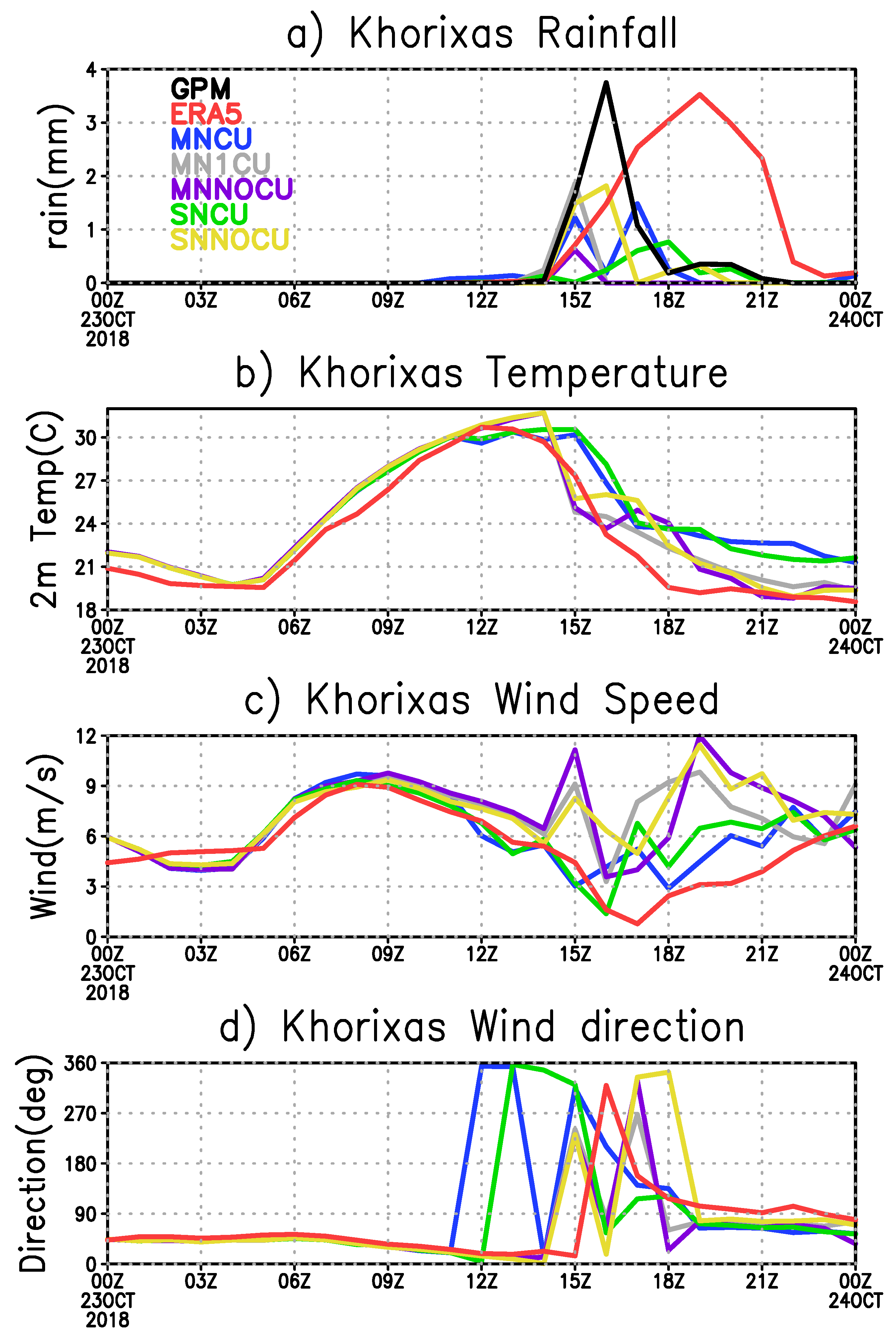
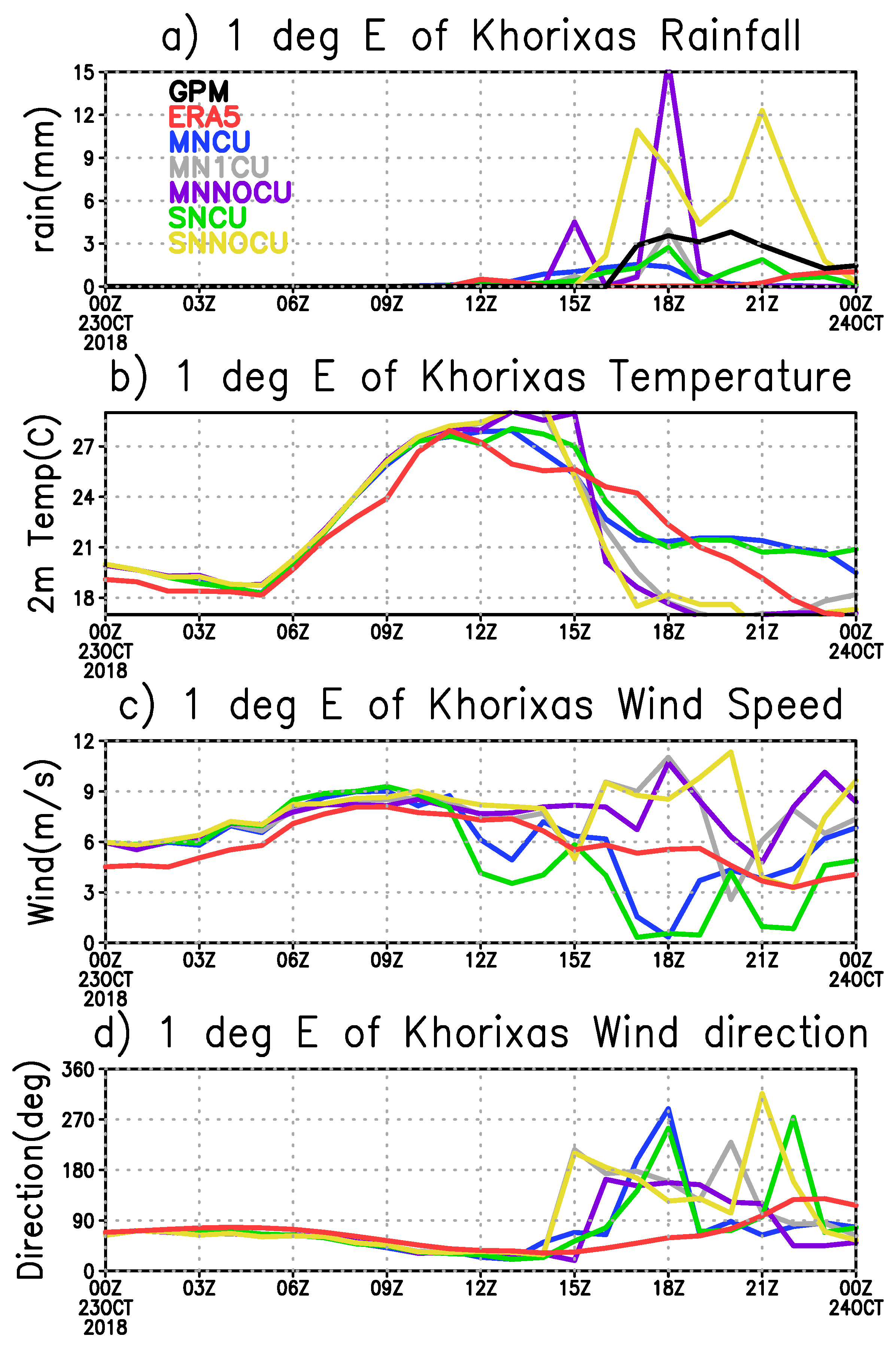
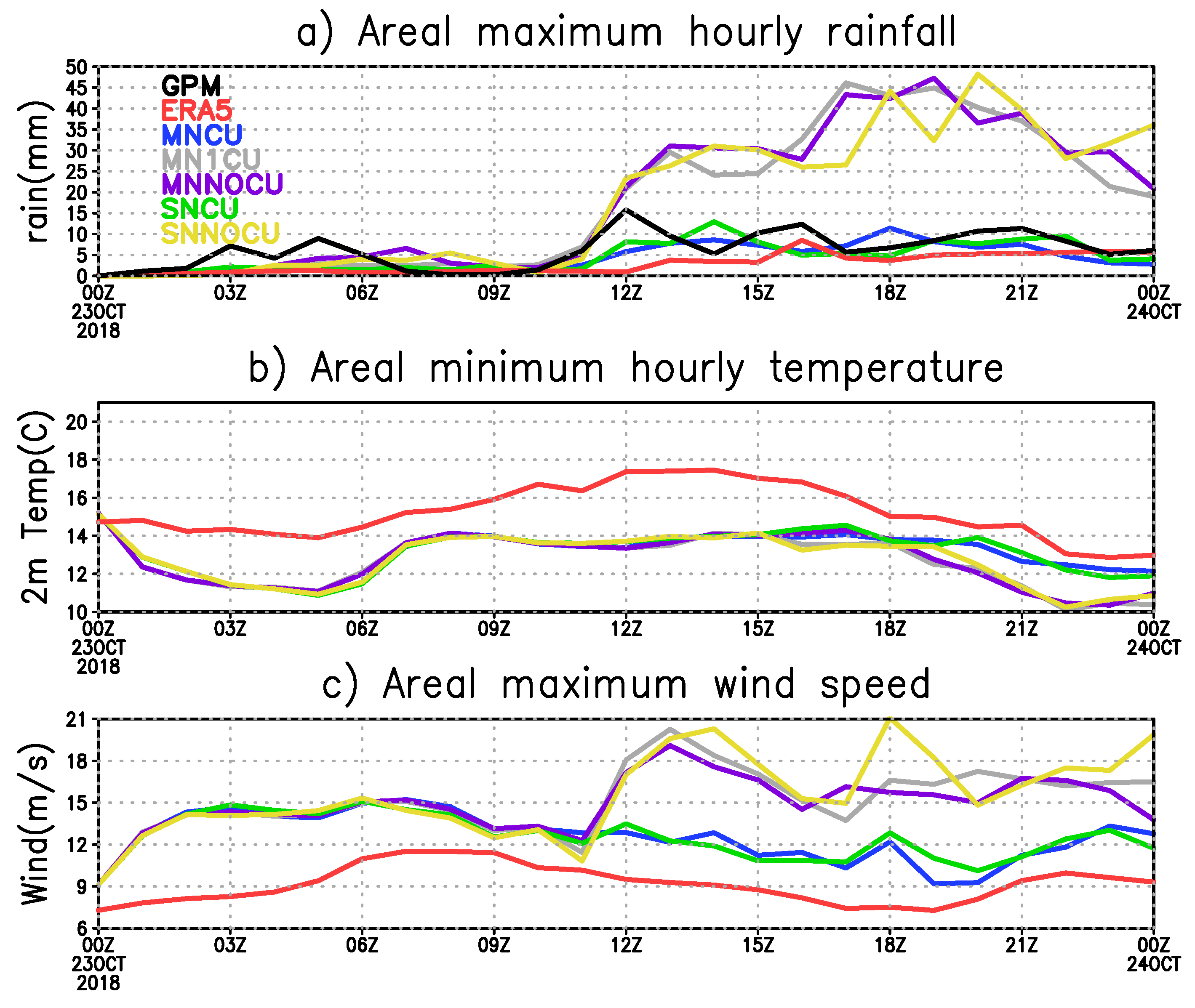

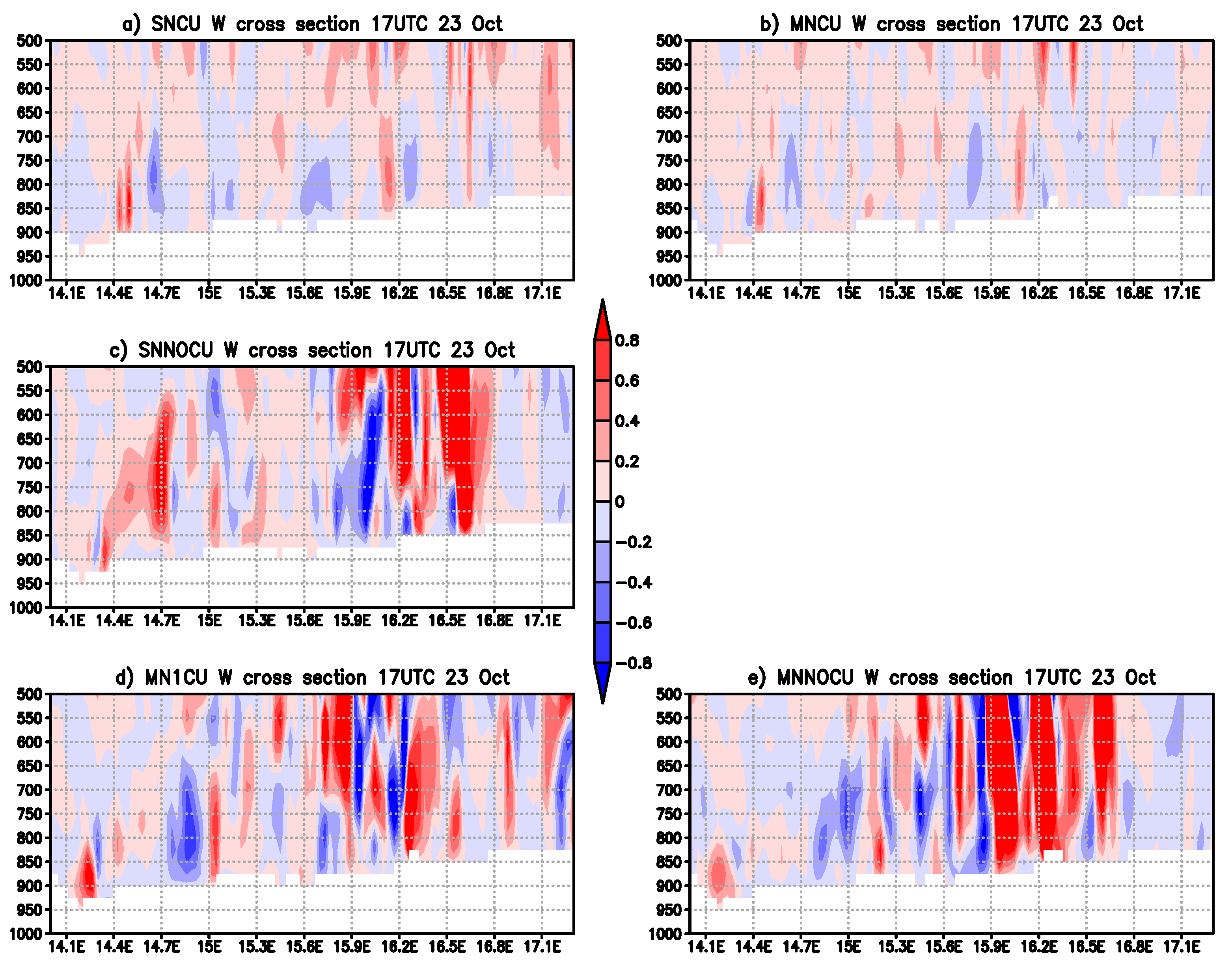
| Parent Domain | Child Domain | Short Name |
|---|---|---|
| 9 km (Yes) | 3 km (Yes) | MNCU |
| 9 km (Yes) | 3 km (No) | MN1CU |
| 9 km (No) | 3 km (No) | MNNOCU |
| 3 km (Yes) | N/A | SNCU |
| 3 km (No) | N/A | SNNOCU |
© 2020 by the authors. Licensee MDPI, Basel, Switzerland. This article is an open access article distributed under the terms and conditions of the Creative Commons Attribution (CC BY) license (http://creativecommons.org/licenses/by/4.0/).
Share and Cite
Somses, S.; Bopape, M.-J.M.; Ndarana, T.; Fridlind, A.; Matsui, T.; Phaduli, E.; Limbo, A.; Maikhudumu, S.; Maisha, R.; Rakate, E. Convection Parametrization and Multi-Nesting Dependence of a Heavy Rainfall Event over Namibia with Weather Research and Forecasting (WRF) Model. Climate 2020, 8, 112. https://doi.org/10.3390/cli8100112
Somses S, Bopape M-JM, Ndarana T, Fridlind A, Matsui T, Phaduli E, Limbo A, Maikhudumu S, Maisha R, Rakate E. Convection Parametrization and Multi-Nesting Dependence of a Heavy Rainfall Event over Namibia with Weather Research and Forecasting (WRF) Model. Climate. 2020; 8(10):112. https://doi.org/10.3390/cli8100112
Chicago/Turabian StyleSomses, Sieglinde, Mary-Jane M. Bopape, Thando Ndarana, Ann Fridlind, Toshihisa Matsui, Elelwani Phaduli, Anton Limbo, Shaka Maikhudumu, Robert Maisha, and Edward Rakate. 2020. "Convection Parametrization and Multi-Nesting Dependence of a Heavy Rainfall Event over Namibia with Weather Research and Forecasting (WRF) Model" Climate 8, no. 10: 112. https://doi.org/10.3390/cli8100112
APA StyleSomses, S., Bopape, M.-J. M., Ndarana, T., Fridlind, A., Matsui, T., Phaduli, E., Limbo, A., Maikhudumu, S., Maisha, R., & Rakate, E. (2020). Convection Parametrization and Multi-Nesting Dependence of a Heavy Rainfall Event over Namibia with Weather Research and Forecasting (WRF) Model. Climate, 8(10), 112. https://doi.org/10.3390/cli8100112






